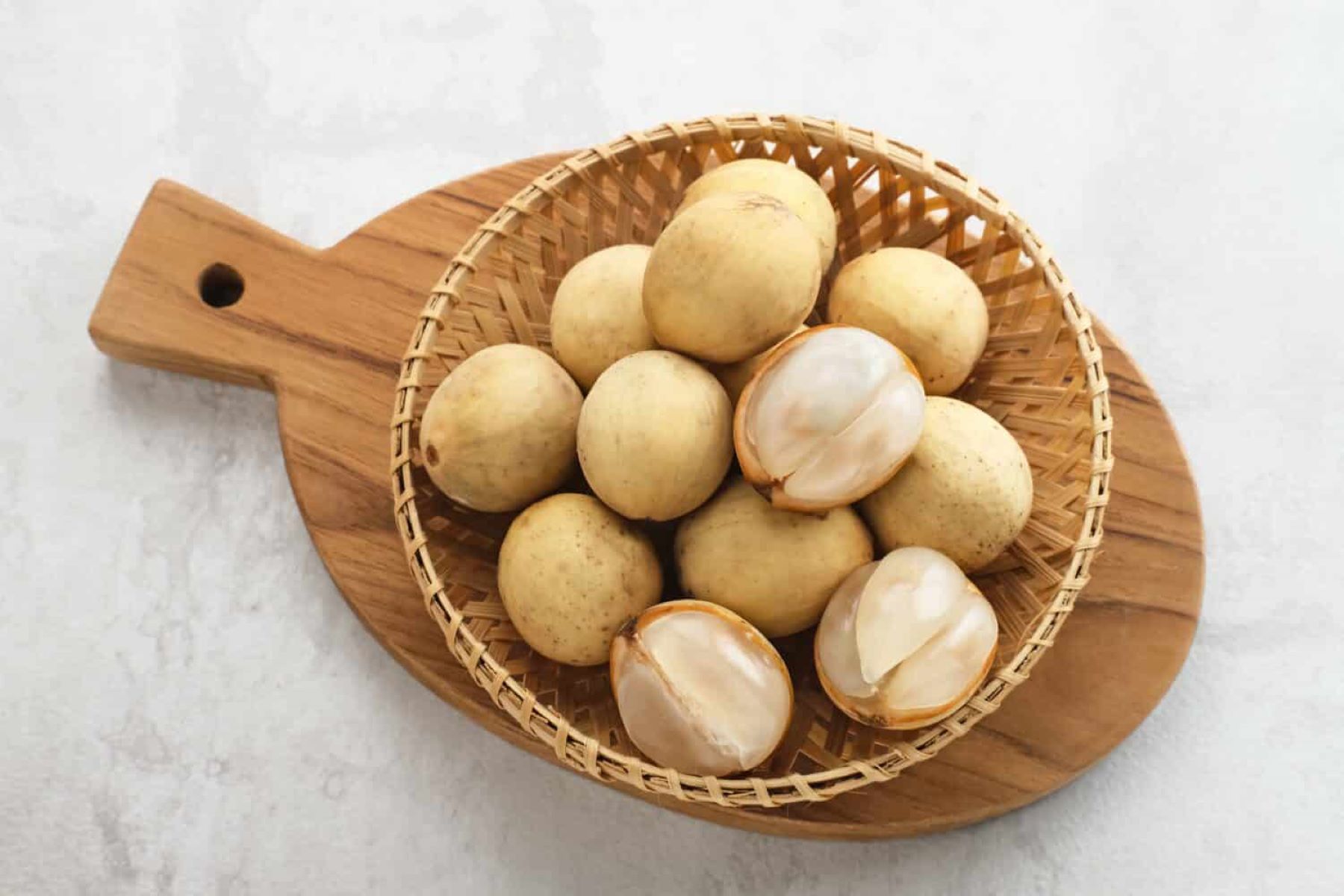Home>Food and Cooking>Dazzling And Delicious Fruits That Start With ‘D’


Food and Cooking
Dazzling And Delicious Fruits That Start With ‘D’
Published: February 5, 2024
Discover a delectable array of fruits that start with the letter 'D' and learn how to incorporate them into your culinary creations with our expert food and cooking tips. Elevate your dishes with these dazzling and delicious fruits!
(Many of the links in this article redirect to a specific reviewed product. Your purchase of these products through affiliate links helps to generate commission for Regretless.com, at no extra cost. Learn more)
Table of Contents
Durian
The durian, often referred to as the "king of fruits," is a tropical fruit known for its distinctive spiky outer shell and pungent aroma. It is native to Southeast Asia, where it is highly revered and enjoyed despite its polarizing reputation. The fruit's unique combination of flavors and textures has made it a subject of fascination for food enthusiasts worldwide.
-
Appearance: The durian is instantly recognizable due to its large size and formidable thorn-covered husk. Its oblong shape and greenish-brown husk give it a striking appearance, making it stand out in any fruit market.
-
Aroma: One of the most polarizing aspects of the durian is its strong aroma, which has been described as a blend of rotten onions, turpentine, and raw sewage. Despite this unappealing description, many aficionados find the scent strangely alluring.
-
Flavor: Beneath the intimidating exterior lies the custard-like flesh of the durian, which offers a complex interplay of sweet, savory, and creamy flavors. Some compare its taste to a rich, creamy custard infused with hints of almond and caramel.
-
Cultural Significance: In Southeast Asia, the durian holds a revered status and is often celebrated during the fruit's peak season. Its significance extends beyond its culinary appeal, as it is deeply ingrained in the region's cultural and social fabric.
-
Health Benefits: Beyond its unique taste and aroma, the durian also offers a range of potential health benefits. It is a good source of energy, rich in dietary fiber, and contains essential vitamins and minerals, including vitamin C, potassium, and copper.
Despite its divisive nature, the durian continues to captivate the curiosity of adventurous food enthusiasts. Whether it's the thrill of trying something truly unique or the desire to experience the flavors of a distant land, the durian has secured its place as a captivating and enigmatic fruit that defies easy categorization.
The durian's allure lies in its ability to evoke strong emotions and spark lively debates, making it a fruit that demands to be experienced firsthand. Whether one finds its aroma off-putting or intriguing, there's no denying that the durian's mystique and complexity make it a truly dazzling and unforgettable fruit.
Date
The date, a lusciously sweet fruit that grows on the date palm tree, has been cherished for its rich flavor and numerous health benefits for centuries. With its origins in the Middle East, this delectable fruit has made its way into cuisines and cultures across the globe, captivating taste buds with its natural sweetness and versatile uses.
Appearance: Dates are small, oval-shaped fruits with a wrinkled, brown outer skin that encases a soft, caramel-colored flesh. Their appearance exudes a natural simplicity, yet their taste is anything but ordinary.
Flavor and Texture: When bitten into, dates offer a delightful combination of chewy and tender textures, accompanied by a rich, honey-like sweetness. Their flavor profile is complex, with hints of caramel, honey, and a subtle nuttiness, making them a versatile ingredient in both sweet and savory dishes.
Culinary Uses: Dates are a staple in various cuisines, where they are used in an array of dishes, from desserts and baked goods to savory tagines and salads. They are often enjoyed stuffed with nuts, dipped in chocolate, or incorporated into energy-boosting snack bars.
Health Benefits: Beyond their delicious taste, dates are packed with essential nutrients, including fiber, potassium, magnesium, and vitamins such as vitamin B6. They are known for their natural sweetness, making them a popular alternative to refined sugars in cooking and baking.
Cultural Significance: In many cultures, dates hold symbolic importance and are often associated with hospitality and generosity. They are frequently offered to guests as a gesture of welcome and are a common feature in festive celebrations and religious observances.
Versatility: Dates are celebrated for their versatility in the culinary world. Whether blended into smoothies, chopped and added to salads, or used as a natural sweetener in desserts, their adaptability makes them a valuable addition to any kitchen.
From their humble appearance to their rich, complex flavor, dates have secured a special place in the hearts of food enthusiasts and health-conscious individuals alike. Whether enjoyed on their own as a wholesome snack or incorporated into a myriad of recipes, dates continue to dazzle with their irresistible sweetness and nutritional benefits.
Dragonfruit
Dragonfruit, also known as pitaya, is a visually stunning tropical fruit that has captured the imagination of food enthusiasts around the world. With its vibrant, otherworldly appearance and subtly sweet flavor, this exotic fruit has become a sought-after ingredient in culinary creations and a beloved addition to healthy, vibrant diets.
Appearance and Varieties: Dragonfruit is characterized by its striking exterior, featuring bright pink or yellow skin with prominent green scales that give it a mythical, dragon-like appearance. There are two main varieties of dragonfruit: one with white flesh speckled with tiny black seeds and another with vibrant magenta flesh. Both varieties offer a mild, subtly sweet flavor with a texture reminiscent of a kiwi.
Nutritional Benefits: Beyond its captivating appearance, dragonfruit is celebrated for its array of health benefits. It is low in calories and rich in essential nutrients such as vitamin C, fiber, antioxidants, and beneficial fatty acids. The fruit's vibrant colors are indicative of its high antioxidant content, which is known to support overall health and well-being.
Culinary Versatility: Dragonfruit's versatility in the kitchen makes it a valuable addition to a wide range of dishes. Its mild flavor and visually appealing flesh make it a popular ingredient in smoothie bowls, fruit salads, cocktails, and desserts. Additionally, its striking appearance lends itself well to decorative garnishes and visually stunning plating in culinary presentations.
Cultural Significance: In addition to its culinary appeal, dragonfruit holds cultural significance in regions where it is cultivated. In certain cultures, the fruit is associated with prosperity, good fortune, and abundance, and is often featured in festive celebrations and traditional ceremonies.
Sustainability and Global Appeal: As global interest in exotic fruits and healthy eating continues to rise, dragonfruit has gained popularity in international markets. Its unique appearance and nutritional benefits have contributed to its status as a symbol of wellness and indulgence, appealing to health-conscious consumers and culinary enthusiasts alike.
From its mesmerizing appearance to its delightful flavor and nutritional value, dragonfruit continues to captivate the senses and inspire creative culinary endeavors. Whether enjoyed on its own or incorporated into a variety of dishes, this dazzling fruit adds a touch of exotic elegance to any dining experience.
Damson Plum
The Damson plum, a small, tart fruit with a distinctive deep purple hue, has a rich history steeped in culinary traditions and folklore. Believed to have originated in ancient Persia and later introduced to Europe, the Damson plum has left an indelible mark on the world of gastronomy with its unique flavor profile and versatile applications.
Appearance and Flavor: The Damson plum is distinguishable by its small size and deep blue-purple skin, which encases a tender, yellow-green flesh. Despite its diminutive stature, this fruit packs a punch in terms of flavor, offering a delightful balance of tartness and sweetness. Its complex taste profile makes it a prized ingredient in a wide array of culinary creations, from jams and preserves to savory sauces and delectable desserts.
Culinary Uses: The Damson plum's distinctive flavor and high natural pectin content have made it a favored fruit for preserving and canning. It is often transformed into robust jams, jellies, and chutneys, where its tartness adds depth and character to the finished product. Additionally, its vibrant color and rich, tangy taste make it an ideal candidate for infusions in alcoholic beverages, such as damson gin or plum brandy, which have become cherished staples in certain regional drinking cultures.
Cultural Significance: Throughout history, the Damson plum has been intertwined with various cultural customs and folklore. In some regions, it is associated with superstitions and believed to possess mystical properties. The fruit's arrival in late summer has also given rise to unique traditions and festivals, where communities gather to celebrate the harvest and share in the bounty of this beloved fruit.
Health Benefits: Beyond its culinary allure, the Damson plum offers a range of potential health benefits. It is rich in antioxidants, vitamins, and dietary fiber, making it a valuable addition to a balanced diet. The fruit's tartness is indicative of its high anthocyanin content, which is known for its anti-inflammatory and antioxidant properties.
Versatility and Adaptability: The Damson plum's adaptability in both sweet and savory dishes makes it a versatile ingredient in the kitchen. Whether baked into pies and tarts, stewed into compotes, or incorporated into savory sauces for meats, its unique flavor adds depth and complexity to a wide range of culinary creations. Its versatility has endeared it to chefs and home cooks alike, who appreciate its ability to elevate dishes with its distinct tangy sweetness.
From its ancient origins to its enduring presence in modern culinary landscapes, the Damson plum continues to enchant with its rich history, vibrant flavor, and cultural significance. Whether enjoyed fresh, preserved, or infused, this small yet mighty fruit remains a cherished gem in the world of gastronomy.
Dewberry
The dewberry, a close relative of the blackberry, is a delightful and lesser-known fruit that grows wild in various regions across the world. With its distinct flavor, charming appearance, and rich historical significance, the dewberry has carved out a special place in the hearts of foragers and food enthusiasts alike.
Appearance and Flavor: Dewberries are small, plump, and dark purple in color, with a sweet-tart flavor that is reminiscent of both blackberries and raspberries. Their delicate, juicy flesh offers a delightful burst of sweetness, underscored by a subtle tartness that adds depth to their flavor profile. The fruit's alluring appearance, with its deep, glistening hue and delicate drupelets, makes it a visually appealing addition to both culinary creations and natural landscapes.
Foraging and Culinary Uses: Dewberries are often sought after by foragers, who eagerly await their brief but bountiful season. These wild-grown treasures are prized for their versatility in the kitchen, where they are transformed into an array of delectable treats. From jams, jellies, and preserves to pies, cobblers, and fruit-forward sauces, dewberries lend themselves to a wide range of culinary applications. Their natural sweetness and vibrant color make them an ideal ingredient for both sweet and savory dishes, adding a touch of rustic charm to any recipe.
Historical Significance: The dewberry's historical significance is deeply rooted in folklore and traditional medicine. Throughout history, dewberries have been associated with various cultural customs and beliefs, often symbolizing abundance, vitality, and the bountiful gifts of nature. In certain cultures, the fruit has been used in herbal remedies and natural tinctures, valued for its potential health benefits and healing properties.
Natural Abundance and Sustainability: The wild, untamed nature of dewberries adds to their allure, as they thrive in diverse ecosystems and are often found in hedgerows, woodlands, and open fields. Their resilience and natural abundance make them a sustainable and eco-friendly choice for those seeking to incorporate locally sourced, seasonal ingredients into their culinary repertoire.
Versatility and Creative Inspiration: Dewberries inspire creativity in the kitchen, encouraging chefs and home cooks to experiment with their unique flavor and texture. Whether enjoyed fresh, baked into pastries, or infused into artisanal beverages, dewberries offer a delightful burst of natural sweetness and a touch of untamed elegance to any dish.
From their humble origins in the wild to their enduring presence in culinary traditions, dewberries continue to captivate with their unique charm and deliciously distinctive flavor. Whether encountered on a leisurely foraging expedition or savored in a homemade delicacy, the dewberry remains a cherished gem in the realm of wild-grown fruits, inviting all who encounter it to savor the simple joys of nature's bounty.
Read more: Incredible Fruit Starting With The Letter I!
Duku
Duku, also known as langsat, is a tropical fruit that hails from Southeast Asia and is celebrated for its delectable taste and unique characteristics. The fruit, which is closely related to the longan and lychee, is a beloved delicacy in the region, where it is enjoyed for its sweet and tangy flavor, as well as its versatile culinary applications.
Appearance and Flavor: Duku is characterized by its small, round shape and pale yellow to light brown skin, which encases translucent, juicy segments. The fruit's flesh offers a delightful combination of sweetness and tartness, with a hint of citrus-like acidity. Its refreshing flavor and juicy texture make it a popular choice for a refreshing snack or a flavorful addition to various dishes.
Cultural Significance: In Southeast Asian cultures, duku holds cultural significance and is often associated with hospitality and communal sharing. It is a common sight in local markets and roadside stalls, where its arrival signals the peak of the fruit season, drawing both locals and visitors eager to indulge in its succulent goodness.
Culinary Uses: Duku's versatility extends to its culinary uses, as it can be enjoyed in a variety of ways. Whether consumed fresh as a standalone treat, added to fruit salads for a burst of flavor, or used in the preparation of refreshing beverages and desserts, duku's sweet-tart profile adds a delightful dimension to culinary creations.
Health Benefits: Beyond its delightful taste, duku offers a range of potential health benefits. It is a good source of essential nutrients, including vitamin C, potassium, and dietary fiber. The fruit's natural sweetness and hydrating properties make it a wholesome choice for those seeking a refreshing and nutritious snack.
Global Appeal: While duku is a cherished fruit in its native regions, its appeal has transcended borders, garnering attention from food enthusiasts and culinary explorers worldwide. Its unique flavor and refreshing qualities have contributed to its status as a sought-after tropical delicacy, drawing interest from those eager to experience its exotic charm.
From its humble origins in Southeast Asia to its growing recognition on the global stage, duku continues to captivate with its delightful flavor and versatile nature. Whether savored on a hot summer day or incorporated into a culinary masterpiece, this tropical gem invites all to revel in the simple pleasures of its sweet and tangy allure.
Dinosaur Egg Pluot
The Dinosaur Egg Pluot, also known as Dapple Dandy Pluot, is a captivating fruit that embodies the perfect marriage of flavors from its plum and apricot lineage. This hybrid fruit, with its intriguing name and delightful taste, has garnered a dedicated following among fruit enthusiasts and culinary aficionados.
Appearance and Flavor: The Dinosaur Egg Pluot is renowned for its striking appearance, featuring a mottled skin that transitions from green to yellow, reminiscent of a dinosaur's egg. Its interior reveals a succulent, honeyed flesh that combines the sweetness of an apricot with the slight tartness of a plum. This harmonious blend of flavors creates a taste sensation that is both familiar and delightfully unique, making it a standout in the world of hybrid fruits.
Culinary Versatility: The Dinosaur Egg Pluot's versatility in the kitchen makes it a prized ingredient for both sweet and savory dishes. Its vibrant flavor and juicy texture lend themselves well to a variety of culinary applications, from being enjoyed fresh in fruit salads and smoothies to being incorporated into jams, preserves, and baked goods. Chefs and home cooks alike appreciate its ability to elevate desserts, imparting a nuanced sweetness that complements a wide range of confections.
Nutritional Benefits: Beyond its delectable taste, the Dinosaur Egg Pluot offers a host of nutritional benefits. It is a rich source of essential vitamins and minerals, including vitamin C, vitamin A, potassium, and dietary fiber. Its naturally sweet flavor makes it a wholesome option for those seeking a nutritious snack, providing a satisfying indulgence without added sugars or artificial ingredients.
Seasonal Delight: The limited seasonal availability of the Dinosaur Egg Pluot adds to its allure, creating a sense of anticipation and excitement among fruit enthusiasts. Its brief appearance on the market prompts a flurry of creative culinary endeavors, as individuals seek to make the most of this fleeting gem of the fruit world.
Elevating the Palate: The Dinosaur Egg Pluot's ability to captivate the palate with its nuanced sweetness and succulent texture has earned it a special place in the realm of hybrid fruits. Whether savored on its own or incorporated into a myriad of culinary creations, this remarkable fruit continues to enchant with its delightful flavor and visual appeal.
The Dinosaur Egg Pluot stands as a testament to the artistry of fruit hybridization, offering a sensory experience that transcends the ordinary and invites all who encounter it to revel in the simple pleasures of its unique and delightful allure.














